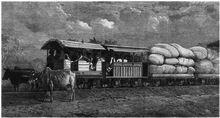Gaekwar's Baroda State Railway
Gaekwar's Baroda State Railway (GBSR) was a narrow gauge railway line owned by the Princely State of Baroda, which was ruled by the Gaekwar dynasty.
History

The railway track has the distinction of being the first narrow-gauge line to be laid in British India, and also the first railway to be owned by any Princely State of India. In 1862, Maharaja Khanderao Gaekwad, the Maharaja of Baroda, inaugurated 8 miles (13 km) of a 2 ft 6 in (762 mm) railway line from Dabhoi to Miyagam. Oxen were used to haul the train, although in 1863, Nielson & Co. built a locomotive to be operated on the line from Dabhoi to Miyagram, as the 6.5 km/m rails were not suited for the regular use of an engine.
Later, during the rule of Maharaja Sayajirao Gaekwad III, the railway's network was further expanded. In 1873, the Dabhoi-Miyagam line (the first 2 ft 6 in (762 mm) line) was re-laid with stronger rails to allow locomotives to be used, rather than oxen. However, locomotives were not regularly used on the line until 1880. During the Maharaja's reign, railway network extended to Goyagate, Chandod, Bodeli and Samalaya Jn with Dabhoi as its focal point.
In 1949, the Gaikwad Baroda State Railway was merged with the Bombay, Baroda and Central India Railway which was subsequently merged in 1951 with other adjacent zones to form Western Railway.
Conversion to broad gauge
The Baroda State Railway is currently under conversion to broad gauge.[2]
See also
References
- "GBSR - Gaekwars Baroda State Railways | History of Vadodara - Baroda". History of Vadodara - Baroda. 1 January 2010. Retrieved 15 January 2018.
- "Dabhoi-Bodeli broad gauge section to become operational". The Times of India. Retrieved 15 January 2018.